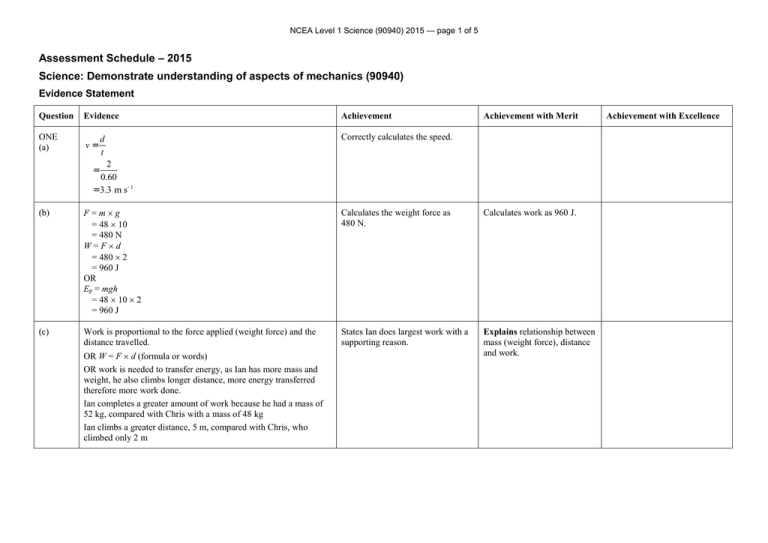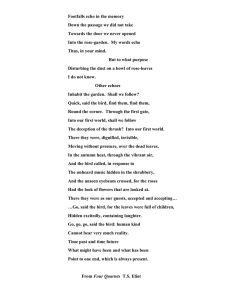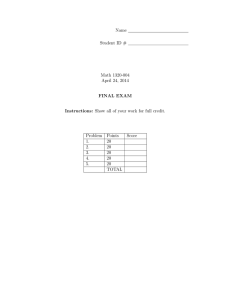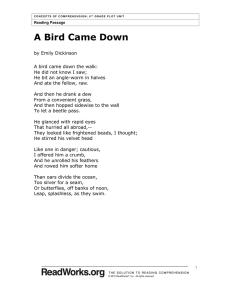(393KB)
advertisement

NCEA Level 1 Science (90940) 2015 — page 1 of 5 Assessment Schedule – 2015 Science: Demonstrate understanding of aspects of mechanics (90940) Evidence Statement Question Evidence ONE (a) v= d t Achievement Achievement with Merit Correctly calculates the speed. 2 0.60 = 3.3 m s -1 = (b) F=mg = 48 10 = 480 N W=Fd = 480 2 = 960 J OR Ep = mgh = 48 10 2 = 960 J Calculates the weight force as 480 N. Calculates work as 960 J. (c) Work is proportional to the force applied (weight force) and the distance travelled. States Ian does largest work with a supporting reason. Explains relationship between mass (weight force), distance and work. OR W = F d (formula or words) OR work is needed to transfer energy, as Ian has more mass and weight, he also climbs longer distance, more energy transferred therefore more work done. Ian completes a greater amount of work because he had a mass of 52 kg, compared with Chris with a mass of 48 kg Ian climbs a greater distance, 5 m, compared with Chris, who climbed only 2 m Achievement with Excellence NCEA Level 1 Science (90940) 2015 — page 2 of 5 (d) Ian had gained gravitational potential energy at the top of the diving board and this was converted into kinetic energy. We assume that all gravitational potential energy will equal the kinetic energy. Ep = mgh Ek = Ep = 52 ´ 10 ´ 5 1 2 mv = mgh = 2600 J 2 1 v2 = 2gh EK = mv 2 OR 2 v = 2gh 1 2600 = ´ 52 ´ v 2 v = 2 ´ 10 ´ 5 2 v v 2600 1 ´ 52 2 = 10 m s -1 = v Uses the correct formula to calculate gravitational potential energy but makes mathematical error. OR 10ms-1 without no working Calculates correct gravitational potential energy and includes unit. Calculates the speed correctly, with unit (one minor error). Recognises conservation of energy is obeyed. Correctly names the two energies for given locations. = 10 m s -1 (e) There are some losses of energy due to friction / air resistance. This means that some of the initial gravitational potential energy is converted into heat and sound as well as kinetic energy. As a consequence, the kinetic energy is less than that calculated (theoretical value), and the boy enters the water at a slower speed. Air resistance / friction occurs as the boy falls, because the boy is pushing past air particles. As the air particles rub against the boy, heat and sound are generated. Identifies that air resistance / drag / friction is the reason for the slower speed. Explains that air resistance / friction causes energy losses / transfers to heat/sound. Explains that air resistance / friction causes losses of energy AND the energy is converted into heat and / or sound AND that, as the kinetic energy (energy of motion) is less, the boy enters the water at a slower speed. (Missing reference to air particles OR missing the kinetic energy is less is a minor error here.) Q1 NØ = no response or no relevant evidence A3 = 3 points M5 = 2 points E7 = 2 points OMI N1 = 1 point from Achievement N2 = 2 points from Achievement A4 = 4 points M6 = 3 points E8 = 2 points NCEA Level 1 Science (90940) 2015 — page 3 of 5 Question Evidence Achievement Achievement with Merit TWO (a)(i) Weight is the downward force due to gravity that an object experiences due to its mass, while mass is a measure of the amount of matter that an object has. OR mass is amount of matter / stuff / molecules in an object, while weight is the force due to gravity. Mass does not change when location changes while weight does; (explaining) this can be given as an example of a person on the earth or on the moon. Defines mass and weight. Explains the difference between mass and weight. (ii) (b) Achievement with Excellence Calculates Fw but uses 630 g in calculation. Correctly calculates Fw. with unit. Fw = m g = 0.630 10 = 6.30 N Net Force: A net force is the resultant (overall/total/sum of) force on an object (when multiple forces interact). If the forces are pointing in the same direction, the forces add, giving a larger net force. If the forces are in opposite direction, the forces subtract, giving a smaller net force (including a zero net force). Net forces determine whether the bird is accelerating, decelerating or maintaining constant speed. If the net force is pointing in the same direction as the direction of motion, the object accelerates. If the net force is pointing in the opposite direction to the direction of motion, the bird decelerates. If there is no net force, the bird maintains constant speed or is stationary. Explanation of motion Diagram A: The bird has constant speed, so the net (horizontal) force is zero. Diagram B: The bird is slowing down, so is decelerating. An unbalanced force is required to make an object’s speed change, therefore, as there is an unbalanced force, the speed will decrease, and the net (horizontal) force is in the opposite direction to the motion of the bird. Describes net force. OR That forces are balanced (the net force is zero) when moving at a constant speed. OR Forces are unbalanced (the net force is not zero) (or there is a negative net force) when slowing down. Explains that unbalanced forces lead to a change in speed. In diagram A (constant speed) the net horizontal force is zero. In diagram B the bird is decelerating, so forces are unbalanced, which causes decrease in speed, with the net force being in the opposite direction to the motion. (To the right or backwards is not sufficient.) NCEA Level 1 Science (90940) 2015 — page 4 of 5 (c)(i) Bird B has the greater acceleration – the gradient / slope of the line is greater. Bird A has an acceleration of: Dv 10 = = 2.50 m s-2 Dt 4 Bird B has an acceleration of: a= a= (ii) Dv 9 = = 3.00 m s -2 Dt 3 Bird A travelled: Calculates the area / distance of section (B) as 100 m. 1 ´ 4 ´ 10 = 20 m 2 (B) 4 – 14 s: d = 10 ´10 = 100 m (A) 0 – 4 s: d = OR Identifies that sections A and / or C are triangles and attempts to find the area using ½b h or other acceptable method but makes an error in the calculation. 1 ´ 2 ´ 10 = 10 m 2 Total distance = 130 m So Bird A has flown 8.50 m further. (130 – 121.5 = 8.50 m) (C) 14 – 16 s: d = Q2 States Bird B has greatest acceleration due to having the greatest gradient. OR Calculates acceleration for either bird. NØ = no response or no relevant evidence N1 = 1 point from Achievement N2 = 2 points from Achievement A3 = 3 points A4 = 4 points Correctly calculates the area / distance of section B (100 m) AND either section A (20 m) OR section C as 10 m. OR Finds the total area / distance by adding each section, but either makes an error with the addition or has made a mistake when calculating ONE section only. Correctly finds the total area 130 m. AND Using the calculations, explains that the Bird A has flown 8.50 m further than bird B. M5 = 2 points E7 = 2 points with one minor error M6 = 3 points (Missing unit minor error) E8 = 2 points NCEA Level 1 Science (90940) 2015 — page 5 of 5 Question THREE (a) (b)(i) (ii) Evidence Achievement A: B: C: D: Describes 3 sections of the graph correctly. Acceleration / increasing speed Constant speed /steady speed Decelerating / decreasing speed Stationary / stopped/at rest (NOT stopping or coming to a stop) Dv (8.3- 0) = m s -2 = 0.277 Dt 30 F = ma = 140 ´ 0.277 = 38.8 N Achievement with Merit Achievement with Excellence Correct calculation of acceleration. a= Correct calculation of force. Calculates work done. Calculates the area of the pontoon correctly. OR Calculates the weight of the pontoon correctly. Calculates the pressure for the pontoon but uses mass instead of weight force. W = F ´ d = 38.8 ´125 = 4848 J (Rounding not assessed.) (c) Surface area of pontoon = 4 3 =12 m2 Weight of pontoon: F = m g = 185 10 = 1850 N F 1850 P= = = 154.2 Pa (N/m² or Nm-2) A 12 Sinking into the water depends on pressure – the greater the pressure, the further the pontoon sinks. F A A ‘lighter’ pontoon will have less weight force than a ‘heavier’ pontoon. In this example, the pontoon has the same area but a greater weight when the people are on it, so the pontoon sinks deeper into the water because the pressure has increased. P= Q3 NØ = no response or no relevant evidence N1 = 1 point N2 = 2 correct points from Achievement States that sinking depth depends on pressure. States that the pontoon with people standing on has more weight force but does not link to pressure. A3 = 3 points A4 = 4 points Explains that the pontoon with 2 people standing on has more mass, therefore more weight force, therefore more pressure (or vice versa for the one without ). Correctly calculates pressure including correct units Compares the weight of the pontoon with and without the people to explain why the pontoon with a greater weight force sinks further into the water. (Unit lacking minor error.) M5 = 2 points M6 = 3 points E7 = 2 points with minor error in one E8 = 2 points Cut Scores Not Achieved Achievement Achievement with Merit Achievement with Excellence 0–7 8 – 13 14 – 19 20 – 24



